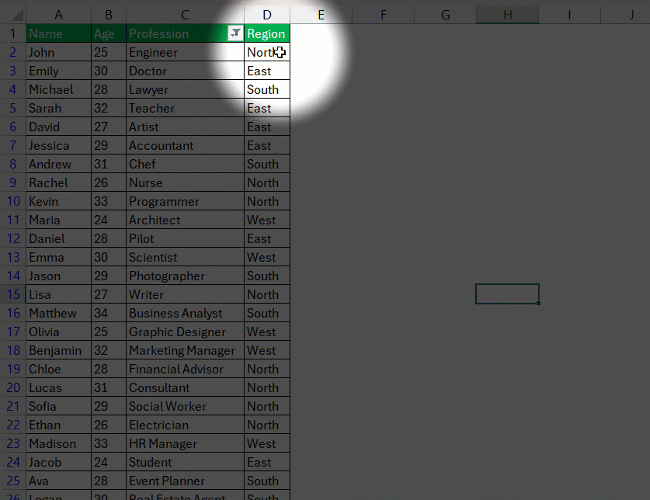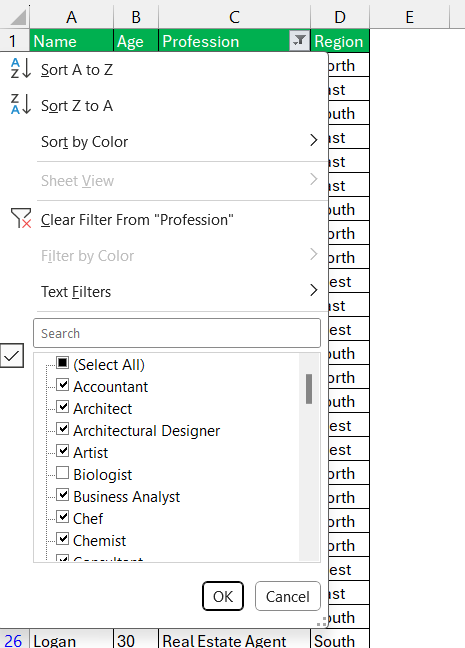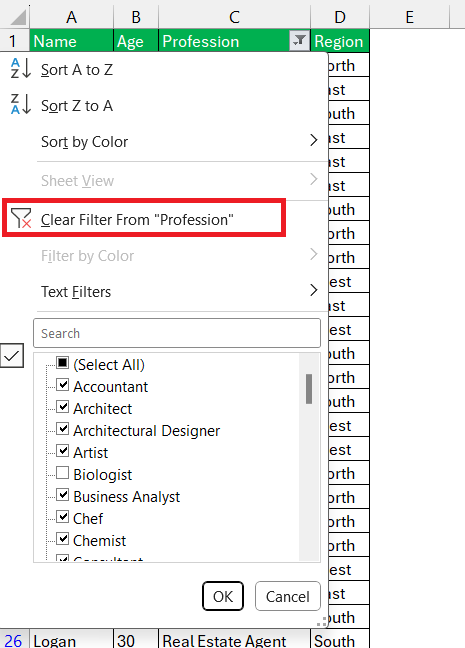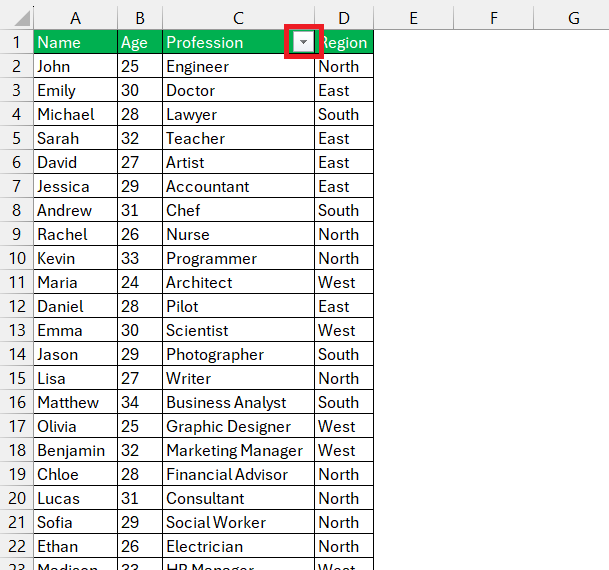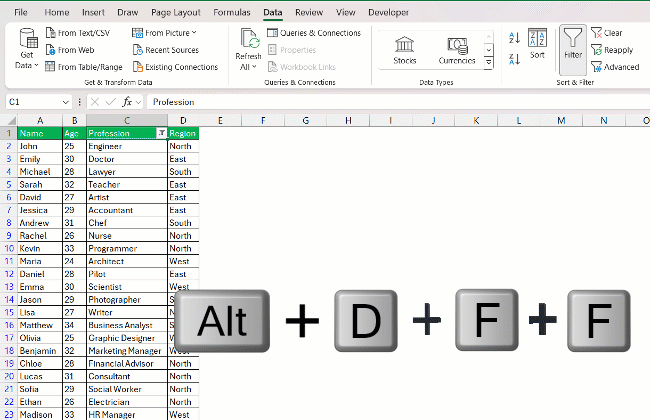Clearing filters in Microsoft Excel is a fundamental task that helps streamline data manipulation and analysis. Filters allow users to focus on specific subsets of data, but clearing them is equally important for viewing the entire dataset or applying new criteria. Understanding how to clear filters ensures accurate insights and efficient workflow management within spreadsheets.
Key Takeaways:
- Efficient Data Focus: Excel filters act like magic wands, helping users pinpoint specific data amidst vast datasets, enhancing focus and productivity.
- No Data Modification: Filtering data in Excel doesn’t alter or delete it; it simply hides irrelevant information, ideal for managing large datasets efficiently.
- Productivity Boost: Quick filtering allows for swift data analysis by displaying only relevant information, akin to clearing fog for clearer insights and faster decision-making.
- Easy Clearing Options: Excel offers multiple methods to clear filters—whether per column or the entire worksheet—tailored to streamline workflow without disruption.
- Keyboard Shortcuts for Efficiency: Mastering Excel’s keyboard shortcuts (like Alt+D+F+F on Windows or Command+Shift+F on Mac) simplifies the process of clearing filters, enhancing efficiency and workflow navigation.
Table of Contents
Introduction to Excel Filter Functionality
Understanding Excel Filters and Their Uses
Excel filters are a bit like magic wands for your spreadsheets. With a few clicks, they allow you to hone in on just the data that interests you, much like using a sieve to separate fine grains from the chaff. Whether you’re dealing with sales figures, survey results, or extensive inventories, filters help you focus on what matters without the distraction of irrelevant information. They’re not just handy; they’re essential for navigating the data sea efficiently.
Imagine you’re looking for a needle in a haystack—Excel filters transform that haystack into a small, neat pile of needles, ready for your perusal. Remember, when you filter data, you’re not deleting or altering it; you’re just choosing to display only the pieces that meet your criteria. This is especially useful when dealing with large datasets where the relevant information is buried under less pertinent data.
The Impact of Quick Filtering on Productivity
Quick filtering in Excel can be a significant boost to your productivity. Fine-tuning data to display only what you need cuts down on the clutter, letting you analyze facts and figures without distraction. Think of it as clearing the fog from your windshield—you can drive forward with greater speed and confidence when you have a clear view.
The beauty of quick filtering is in its instantaneous nature. Need to compare quarterly sales figures? Filter them in just a few clicks. Looking to identify trends in customer feedback? Apply a filter, and you’re already halfway to insights. By incorporating quick filtering into your routine, you transform overwhelming data into manageable tiles, ready to be explored. This efficient approach translates to hours saved and a more streamlined workflow, which is vital for meeting tight deadlines and managing time-sensitive projects.
The Step-by-Step Mechanics to Clear Filters
Clear a Single Column Filter with Ease
Removing a filter from just one column in Excel is like telling a single musician to pause while the rest of the orchestra keeps playing. It’s perfect for moments when you want to reset the view of one aspect of your data but leave the rest of your filters tuned to the right pitch. Here’s how you do it:
STEP 1: Position your cursor over the top of the column with the filter you want to remove. Notice the filter icon; it tells you there’s a filter applied.
STEP 2: Click on this icon, and a dropdown menu appears, brimming with options.
STEP 3: Here’s the magic move: select “Clear Filter From [Column Name].”
With this step, the filter vanishes from that specific column, but your other data keeps playing its harmonious tune.
This is especially beneficial when you’re fine-tuning your analysis and only need to change one element. No need to disrupt your entire dataset; just a quick tweak, and you’re done.
Wiping the Slate Clean: Removing All Filters at Once
Sometimes, you need to step back and see the full picture—all the rows and columns in their unfiltered glory. Wiping the slate clean of all filters in your Excel worksheet is a straightforward process:
STEP 1: Navigate to the ‘Data’ tab.
STEP 2: Look for the ‘Sort & Filter’ cluster of commands. It’s here that you hold the key to clearing the filters.
STEP 3: With a click on “Clear,” you banish all filters from your worksheet. Every hidden row and column resurfaces, giving you a pristine data tableau to work with anew.
It’s an instant refresh for your dataset, allowing you to rethink your approach or prepare to apply a new set of filters. Much like resetting a game to try a different strategy, wiping all filters lets you start over with fresh eyes.
Keyboard Shortcuts: Your Swift Path to Unfilter Data
Mastering Excel’s Clear Filter Hotkeys
Keyboard enthusiasts rejoice! Excel’s clear filter hotkeys can turn what might feel like a treasure hunt through menus into an instant find. They’ve carved out a swift path to unfiltered data, and getting these keystrokes down can feel just as satisfying as crossing off an item on your to-do list.
For those who’ve arranged their hands on Excel’s grid as often as the cells, tapping Alt+D+F+F on Windows is your keyboard shortcut to toggle filters off in the selected range.
Mac users aren’t left out; they have the snappy Command+Shift+F combination. These hotkeys don’t just clear the filters; they flip the feature on or off, giving you control without dragging your mouse for a click-fest.
By embedding these keyboard tricks into your muscle memory, you can navigate big datasets with the dexterity of a pianist running scales—effortlessly and efficiently.
Troubleshooting: When Shortcuts Don’t Seem to Work
Are you tapping away at your keyboard and finding that Excel just isn’t responding the way you expected? This can happen when you’re trying to clear filters using shortcuts, and there can be a few reasons why they don’t quite work.
Firstly, check if your workbook is shared or protected. Both settings can restrict certain actions, including the use of shortcuts. If it’s shared, you might need to unshare it temporarily to perform your task. For protected sheets, entering the password to unprotect the sheet should do the trick.
Another culprit could be Excel Add-Ins or a different Excel mode that’s active, which can override the default shortcuts. Check to see if an Add-In is the interference source or if Excel is in a different mode, like cell-editing or a dialogue box is open; these scenarios could absorb the shortcuts before they perform their intended action.
Lastly, your hands could be playing an accidental game of ‘Twister’. Verify the key combination, and remember that some keyboards require you to press an ‘Fn’ or ‘Function’ key to access certain shortcuts.
If all else fails, defaulting back to the mouse isn’t a defeat—it’s just another tool at your disposal. Don’t let a stubborn shortcut hinder your flow; adapt and conquer!
Practical Scenarios for Removing Filters
Case Study: Streamlining Data Review Processes
Imagine a bustling sales department faced with the Herculean task of sifting through thousands of transactions each quarter to identify top-performing products and flag any unusual sales patterns. The team used to trawl through the data manually, which was as time-consuming as it was soul-crushing. Enter Excel filters—a game changer.
Following the adoption of filters, the process was revolutionized. By applying filters to isolate various sales metrics—like highest-grossing products or irregular transaction volumes—the team could efficiently highlight key areas of interest. This wasn’t just a small improvement; it was a leap forward.
Filters enabled the sales team to cut their data review time by more than half while improving their precision in catching errors and recognizing opportunities. Spreadsheets that once took days to go through could now be dealt with in hours, turning what was once a dreaded task into an efficient, manageable one.
FAQ (Frequently Asked Questions)
How do I clear the filter in Excel?
To clear a filter in Excel, simply click on the Data tab, then head over to the Sort & Filter group and press ‘Clear’. All filters applied to your sheet will be removed and you’ll see your full dataset once again. For individual column filters, click the filter icon in the column header and select ‘Clear Filter From [Column Name]’.
How to use keyboard shortcut for filter in excel?
To use the keyboard shortcut for filtering in Excel, press Ctrl+Shift+L to toggle filters on or off for the current data range. If you want to activate the filter dropdown for a specific column, select the cell in the header row and press Alt+Down Arrow. This will open the filter menu for that column.
Can You Remove Filters from Multiple Sheets at Once?
Unfortunately, Excel doesn’t offer a built-in feature to remove filters from multiple sheets in one go. You’ll need to go one by one—select each sheet, head to the Data tab, and click ‘Clear’ to remove filters. Alternatively, for a more advanced solution, you can use a VBA script to loop through all sheets and clear filters.
Why Won’t Excel Clear a Filter When I Use the Shortcut?
If Excel won’t clear a filter when using the shortcut, ensure the worksheet isn’t protected or shared, as this can restrict shortcut use. Check if an Excel Add-In is interfering or if Excel is in a state that doesn’t recognize the shortcut, like editing a cell. Also, verify the keyboard shortcut is correct for your version of Excel and system.
Why can’t I remove the filter in Excel?
If you can’t remove a filter in Excel, it might be because the workbook is shared or protected, or there’s an active cell in edit mode. Other issues can include conflicting Excel Add-Ins or Excel limitations on certain types of data like tables or PivotTables. Ensure you’re following the right steps, and if all else fails, consider looking for any error messages that could guide you to the specific problem.
John Michaloudis is a former accountant and finance analyst at General Electric, a Microsoft MVP since 2020, an Amazon #1 bestselling author of 4 Microsoft Excel books and teacher of Microsoft Excel & Office over at his flagship MyExcelOnline Academy Online Course.

